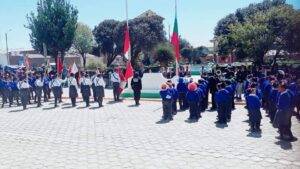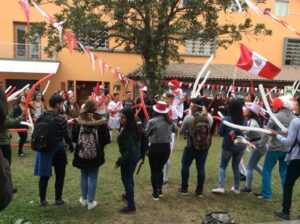Peruvian people celebrate the national days called “Fiestas Patrias” during two days – 28 and 29 July.

On 28 July we remember the day that General Don José the San Martín signed the Independence Act and proclaimed that Perú was independent from the Spanish Crown. It took place in Huaura, a small town close to Lima. Houses, private and public buildings, display the flag of Perú.
This event was, to put it, only somewhat formal because the form of government and the leadership positions at the time were assumed by people whose parents were Spanish but who were born in Peru. They were called “Criollos” and they were the aristocrats of that time. Criollos wanted the opportunity to assume power and with the differences of social classes, the subjugation of the indigenous as slaves continued.
In schools, the historical version of independence is still presented as an achievement, however, other historians currently point out, from new research, that independence was “conceded,” says Moran (2015). Moran makes this claim in a book that compiles articles produced by renowned Peruvian historians who support this thesis based on historical documents and accounts. Liberating Peru from the Spanish Crown was a result of a series of internal and external events, almost a necessary objective, to ensure the independence of the South American countries that had achieved so much leading to their Independence. It should be noted that Peru is geographically in a strategic place, which allowed important critical political, economic and military actions for Spain to control the “countries” that were part of its colonies.
Remembering this event today is a challenge. 199 years have passed and Peru is still endeavouring to build a country that embraces its cultural diversity; revalues its traditions and promotes sustainable public policies that aim to enhance such. Although Peruvians carry out activities that honor their history, every 28 & 29 July, because they are public holidays, they need to seriously address issues such as: corruption, discrimination, poverty, precarious basic health services, poor investment in education and address unemployment. The experience of the COVID 19 pandemic has exposed and highlighted all these issues even more.

The bicentennial celebration is an opportunity to strengthen progress. Until 2019, people enjoyed these days doing different activities: tourism, visiting historical centers, museums, circuses, fairs, etc. In schools, traditional “marches” were held in which children dressed up as police, military, doctors, nurses, firefighters etc. Some students dressed representing the 3 Regions of the coast, the mountains and the jungle. They march through the streets of cities in many parts of Peru. On 28 July the President gives his Presidential speech and an account of the development of the State during the year. On 29 July, the traditional Military Parathe takes place – the armed forces, air force, the police, firefighters march and the air force planes mathe creative air demonstrations. Traditional dancing also forms part of the celebrations.
This year all these celebrations will not take place because of the current situation. The nation is still trying to get ahead due to the health crisis and the poverty in which thousands of people are submersed. This is compounded by the fact that in recent years Peru has received close to 1 million Venezuelan migrants due to the situation of poverty and internal violence in their own country. The desire to get ahead has mathe Peruvians continue to be creative. For this reason, those who are part of this country have much to do and the Sisters of Saint Joseph are more committed to the mission of caring for the most vulnerable people in schools, parishes, universities and working with other institutions in networks.
Sr Jenny Mori L rsj
